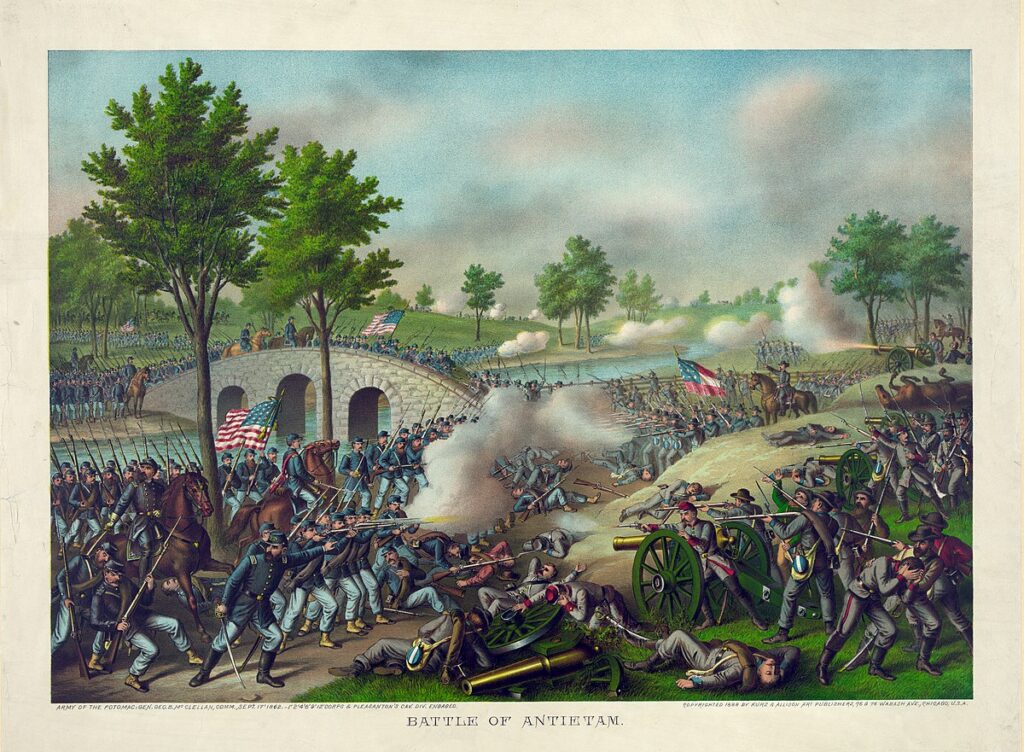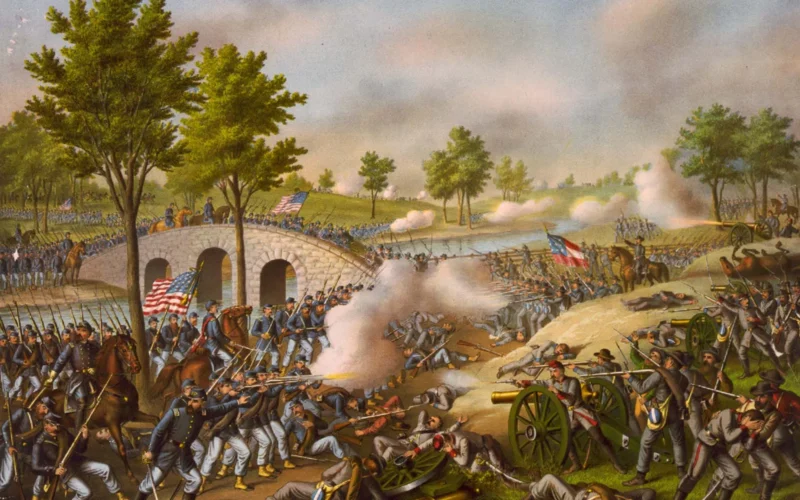The American Civil War was a conflict that lasted from 1861 to 1865, and was fought between the United States of America (the Union) and 11 Southern states that had seceded and formed the Confederate States of America. The main cause of the war was the disagreement between the North and South over the issue of slavery, which had long been a source of tension in the country. The election of President Abraham Lincoln, who was opposed to the spread of slavery, was the catalyst for the Southern states to secede.
The Confederate army, led by General Robert E. Lee, fought against the Union army, led by a series of commanders including Generals Ulysses S. Grant and George B. McClellan. The war resulted in a Union victory, the abolition of slavery, and significant changes to the U.S. Constitution. Over 620,000 soldiers and an unknown number of civilians lost their lives in the war, making it one of the deadliest conflicts in American history.
The Battle of Antietam
The Battle of Antietam was fought on September 17, 1862, in Sharpsburg, Maryland. It was a major engagement in the American Civil War between the Confederate Army of Northern Virginia, commanded by General Robert E. Lee, and the Union Army of the Potomac, commanded by General George B. McClellan.
The battle began early in the morning, with Confederate forces crossing the Potomac River into Maryland and attacking Union forces near the town of Sharpsburg. The fighting was intense and brutal, with both sides suffering heavy casualties. The first day of the battle saw the most casualties, with over 20,000 men being killed or wounded. The fighting continued into the second day, with Union forces pushing the Confederate army back, but unable to break their defenses.
One of the key moments of the battle was the Confederate attack on the Union center at the Sunken Road, also known as “Bloody Lane.” Confederate forces attempted to break through the Union line, but were met with heavy resistance and suffered severe losses. Despite this setback, the Confederate army continued to fight, and the battle remained in a stalemate for much of the day.

Towards the end of the second day, General McClellan was given reinforcements, and he ordered a final attack on the Confederate left flank. This attack was successful, and the Confederate army was forced to retreat. The Battle of Antietam ended in a tactical draw, but it was a strategic victory for the Union, as General Lee’s invasion of the North was stopped.
The Battle of Antietam was a significant turning point in the American Civil War, as it prevented the Confederate army from making further advances into the North. The Union victory at Antietam also allowed President Abraham Lincoln to issue the Emancipation Proclamation, declaring all slaves in Confederate territory to be free. The battle remains one of the bloodiest single-day battles in American history, with over 23,000 casualties.
Phases of the Battle
The Battle of Antietam had several phases, which can be described as follows:
- Confederate Invasion of Maryland: On September 4, 1862, Confederate General Robert E. Lee led his army across the Potomac River into Maryland, where he hoped to gain support from the state’s pro-Confederate citizens and to threaten the Union capital of Washington D.C.
- Union Advance and Confederate Defenses: On September 16, Union General George B. McClellan’s army caught up with Lee’s army near Sharpsburg, Maryland. Lee deployed his troops in a strong defensive position along Antietam Creek, with his left flank anchored on the Potomac River and his right flank protected by the hills overlooking the creek.
- The First Day’s Fighting: On the morning of September 17, Union forces launched several attacks on the Confederate left flank along the creek. The fighting was intense, with both sides suffering heavy casualties. The Union army was unable to break through the Confederate defenses, and the fighting continued throughout the day with neither side gaining a significant advantage.
- The Second Day’s Fighting: On the second day of the battle, Union General McClellan was given reinforcements, and he ordered a final attack on the Confederate left flank. This attack was successful, and the Confederate army was forced to retreat. The battle ended with the Confederate army in a defensive position along the hills overlooking Antietam Creek.
- The Aftermath: The Battle of Antietam ended in a tactical draw, but it was a strategic victory for the Union, as General Lee’s invasion of the North was stopped. The Union victory allowed President Abraham Lincoln to issue the Emancipation Proclamation, declaring all slaves in Confederate territory to be free. The battle remains one of the bloodiest single-day battles in American history, with over 23,000 casualties.
First Day of Battle

The first day of the Battle of Antietam, on September 17, 1862, was a critical moment in the American Civil War. Here is a detailed account of the events of that day:
- Union Advance: In the early morning hours, Union forces advanced towards Confederate positions along Antietam Creek. The Union army was divided into several corps, each assigned to attack a different part of the Confederate line.
- Confederate Defense: The Confederate army was deployed in a strong defensive position along the creek, with their left flank anchored on the Potomac River and their right flank protected by the hills overlooking the creek. The Confederate army was well-entrenched and prepared for the Union advance.
- The First Attacks: The first Union attack was launched against the Confederate left flank along the creek. The fighting was intense, with both sides suffering heavy casualties. The Confederate army was able to hold its ground, and the Union attack was repulsed.
- The Struggle for the Sunken Road: One of the key moments of the first day’s fighting was the Confederate attack on the Union center at the Sunken Road, also known as “Bloody Lane.” Confederate forces attempted to break through the Union line, but were met with heavy resistance and suffered severe losses. Despite this setback, the Confederate army continued to fight, and the battle remained in a stalemate for much of the day.
- Continued Fighting: The first day of the battle saw continued fighting along the entire front, with neither side gaining a significant advantage. The Union army was unable to break through the Confederate defenses, and both sides suffered heavy casualties. By the end of the day, over 20,000 men had been killed or wounded.
- The End of the First Day: As night fell, the battle ended with the Confederate army still in a strong defensive position along the hills overlooking Antietam Creek. The first day of the battle was a brutal and bloody affair, with both sides suffering heavy casualties. Despite this, the battle would continue into the next day, with the outcome still in doubt.
Second Day of Battle
The second day of the Battle of Antietam, on September 18, 1862, was the decisive day in the battle, with Union General George B. McClellan launching a final attack on the Confederate army. Here is a detailed account of the events of that day:
- Reinforcements: On the second day of the battle, General McClellan received reinforcements, including several divisions from General John Pope’s army. With these reinforcements, McClellan was able to assemble a larger army for a final attack on the Confederate left flank.
- The Final Attack: In the late morning, McClellan ordered his army to launch a final attack on the Confederate left flank. The attack was launched in several stages, with Union forces advancing up the hills overlooking Antietam Creek and engaging the Confederate army in fierce fighting.
- Confederate Retreat: Despite their strong defensive position, the Confederate army was unable to hold back the Union attack, and they began to retreat. The Confederate retreat was not an organized withdrawal, but rather a chaotic retreat as Confederate soldiers fled the battlefield in small groups.
- The Aftermath: By the end of the second day of the battle, the Confederate army was in full retreat and the Union army was in pursuit. The Battle of Antietam ended in a tactical draw, but it was a strategic victory for the Union, as General Lee’s invasion of the North was stopped. The Union victory allowed President Abraham Lincoln to issue the Emancipation Proclamation, declaring all slaves in Confederate territory to be free.
- Casualties: The second day of the battle was just as bloody as the first, with both sides suffering heavy casualties. Over 23,000 men were killed or wounded in the two days of fighting, making the Battle of Antietam one of the bloodiest single-day battles in American history. Despite the high cost in lives, the Union victory at Antietam was a critical moment in the Civil War, and it marked a turning point in the conflict in favor of the Union.

The Battle of Antietam as the Bloodiest Day in American History
The Battle of Antietam, fought on September 17, 1862, is often considered to be the bloodiest day in American history. On that single day, over 23,000 men were killed or wounded, making it one of the deadliest single-day battles in American history. The battle was fought between the Confederate army, commanded by General Robert E. Lee, and the Union army, commanded by General George B. McClellan.
The Battle of Antietam was a critical moment in the American Civil War, as it was the first major battle fought on Northern soil and marked the end of General Lee’s first invasion of the North. The battle resulted in a tactical draw, but it was a strategic victory for the Union, as Lee’s army was forced to retreat back into Virginia.
The high number of casualties at Antietam shocked the nation and underscored the brutal reality of the Civil War. The battle was a turning point in the war, and it paved the way for the Union’s eventual victory. The memory of the Battle of Antietam and the sacrifices made by both Union and Confederate soldiers continues to live on, serving as a reminder of the high cost of war and the importance of preserving the Union.
Conclusion
In conclusion, the Battle of Antietam was a pivotal moment in the American Civil War, fought between the Confederate army led by General Robert E. Lee and the Union army led by General George B. McClellan on September 17, 1862. The battle was fought on Northern soil and marked the end of General Lee’s first invasion of the North. It resulted in a tactical draw but was a strategic victory for the Union, as Lee’s army was forced to retreat back into Virginia.
The Battle of Antietam was also the bloodiest single-day battle in American history, with over 23,000 men killed or wounded. The high number of casualties shocked the nation and underscored the brutal reality of the Civil War. The battle was a turning point in the war and paved the way for the Union’s eventual victory. The memory of Antietam and the sacrifices made by both Union and Confederate soldiers continues to serve as a reminder of the high cost of war and the importance of preserving the Union.


